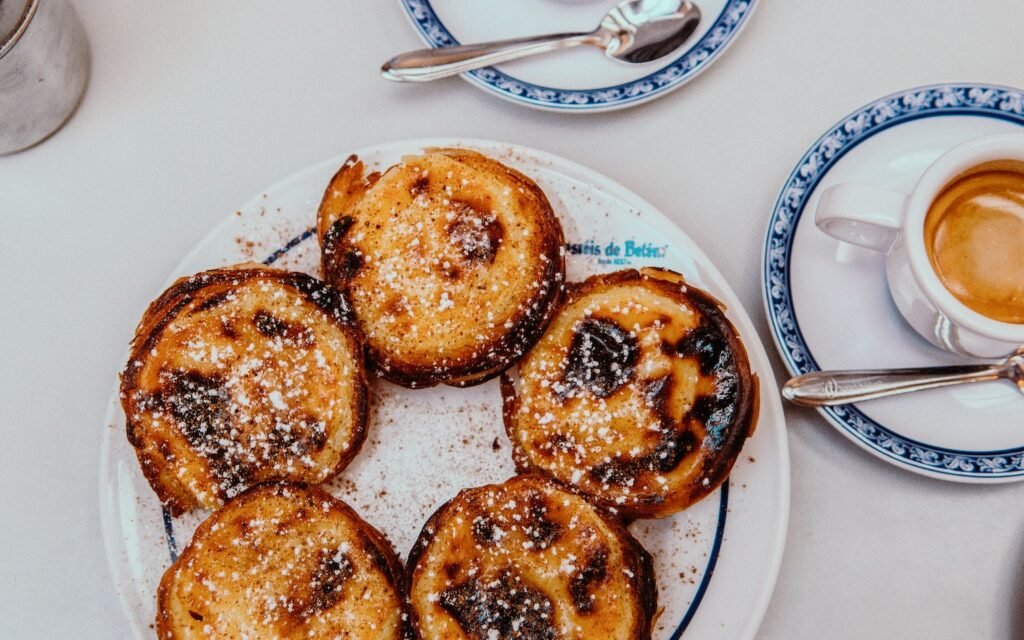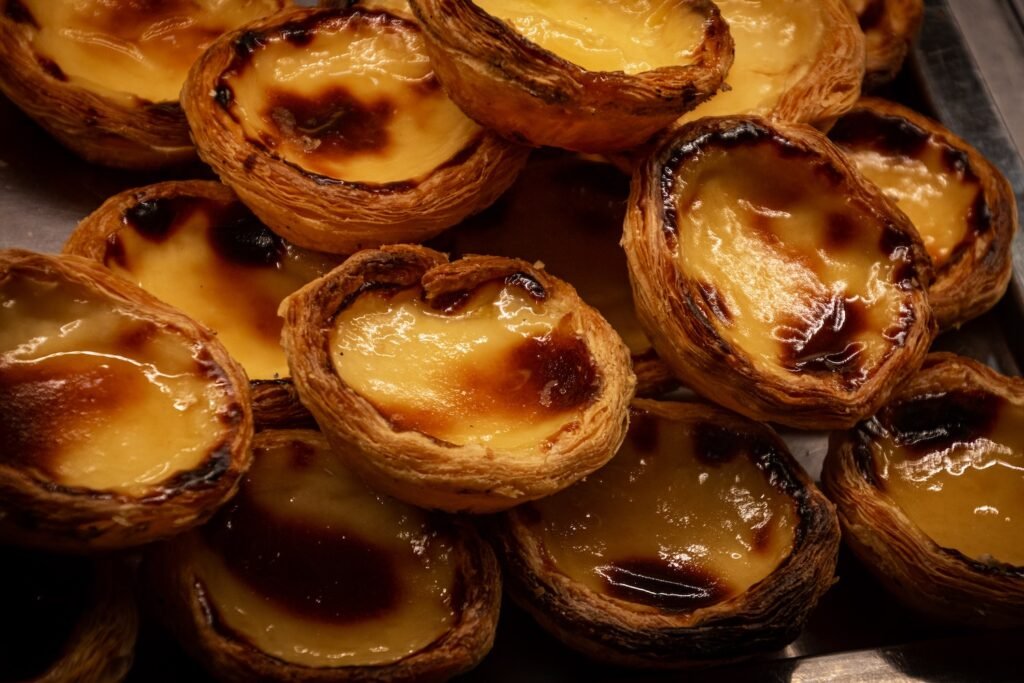Are you a fan of sweet, creamy desserts? If so, then the first sweet treat you want to try when visiting Portugal is the famous pastéis de nata — Portuguese custard tarts!
Flaky and buttery on the outside and fluffy and airy on the inside, pastéis de nata are one of Portugal’s most beloved traditional treats (and by far the most beloved Portuguese sweet treat of all our friends and family who have visited us so far — although pão de Deus is a close second).
Follow along as we explore what makes pastéis de nata so great: their history and culture, their ingredients and variations, and tips for ordering them when you visit Portugal.
The Most Famous Pastry in Portugal

So, let’s start with the obvious question. What the heck are pastéis de nata? In English, the term translates to (roughly) cream pastry. They consist of an outer shell of flakey puff pastry that is filled with a creamy custard filling made from egg yolks, sugar, and cinnamon.
With their delicious flavors and crispy pastry layers, pastéis de nata are perfect for when you have a sweet craving, especially if you’re looking for something beyond your traditional goodies like croissants or bolos de arroz. They’re even better when paired with an afternoon espresso or tea.
Pro Tip: Pair a pastéis de nata with black espresso to enhance the sweet, sugary flavor (and cinnamon) even more.
The History of Pastéis de Nata
The history of pastéis de nata dates back to the 18th century in a place that is now a UNESCO World Heritage Site — the iconic Jerónimos Monastery (add this spot to your must-see list when visiting Lisbon as it’s super accessible by tram and right near the heart of Belém).
To make these pastries, the monasteries used up all the leftover egg yolks from starching clothes with egg whites. If you’re wondering why Portugal seems to be overflowing with sweet treats, this is why. It was common for convents and monasteries to use the leftover egg yolks to make cakes and other pastries, which is why the country is a sugar addict’s dream these days.
It wasn’t until the early 1800s that the monks started to sell the pastéis de nata widely. Following the Liberal Revolution of 1820 that dissolved religious orders, the monks started selling pastéis de nata at a nearby sugar refinery to bring in money for their monastery.
While they’ve been around for hundreds of years, they’ve recently garnered more (well-deserved) attention due to the influx of tourists to Portugal, the advent of social media sharing, and a 2019 Bloomberg article that predicted that the pastéis de nata will soon become as ubiquitous as the croissant.

Itinerary Tip: This is what the Jerónimos Monastery looks like on the inside. While they don’t serve pastéis de nata here anymore, they do just down the road at Pastéis de Belém. The monastery is well worth a visit. Take time to explore the intricacies of the unique architecture here (and bring a camera, as you’re going to want to snap tons of pictures).
What Are Pastéis de Nata Made Of?
These irresistible treats are made from creamy egg custard and flaky puff pastry. The pastéis’ signature caramelized top is created with the addition of cinnamon and sugar, which is added to the custards before baking.
Many recipes for pastéis de nata call for add-ins like vanilla, lemon zest, and cream. However, you won’t find the most iconic pastéis de nata shops publishing their ingredients, so it’s tough to tell just what’s inside some of the best pastéis de nata in places like Lisbon.
Additionally, some places (mostly touristy places in the city centers) now offer unique variations of pastéis de nata that include ingredients like Nutella, caramelized apple, and pistachio. We tried Nutella and cinnamon apple pastéis de nata in Lisbon once, and while the flavors were certainly different from the traditional pastries, they were still pretty freaking good.
They’re also traditionally served with powdered sugar and cinnamon. Most places will put containers full of each ingredient on the table so you can add the powdered sugar or cinnamon yourself. We’d definitely suggest trying one of each as they offer different additions to the already great flavors of a plain pastéis de nata.
Where Is the Best Pastéis de Nata?

Whew. That’s a big and heavily contested topic. Let’s start by discussing the most culturally popular place to enjoy a pastéis de nata. If you want to enjoy the absolute best pastéis de nata, then everybody will tell you that you must visit Pastéis de Belém.
This shop has been around since 1837, selling the very same recipe used by members of a monastery who were forced to close their doors a few years earlier. Located just three minutes from Jerónimos Monastery, this shop sees lines of people coming out their door daily. They’ve garnered over 60,000 reviews on Google, and rightfully so. Their pastéis de nata are delicious.
However, because they refuse to participate in the annual Portuguese competition of “O Melhor Pastel de Nata,” it’s hard to say with certainty that they offer the best Portuguese custard tart. In 2022, the first-place prize went to a place called Casa do Padeiro (which also won the prize for the best bolo rainha in 2021).
We haven’t tried Casa do Padeiro’s pastéis de nata, but of all the ones we’ve tried in Lisbon, we are adamant about the fact that a small pastry shop near our apartment called Arabesco sells the absolute best. The ones at Pastéis de Belém are actually worth the hype, too.
How to Order Pastéis de Nata
First, understand how much you should pay for one of these sweet treats. When we first moved to Lisbon, a local told us to never pay more than €1 for a pastéis de nata, even in places like Lisbon. If they’re asking you to pay more than a euro, you’re likely getting ripped off (however, with prices rising as they are, this might change in the future).
Now, how do you ask for a pastéis de nata? Understand that pastéis de nata is actually plural. If you want just one, as for a pastel de nata. Then, think about the toppings you might want. As mentioned above, most places place shakers full of cinnamon and powdered sugar on the tables for you to serve yourself with. However, if they don’t, you might ask for a “pastel de nata com canela” if you want to try it with cinnamon, for example.
Our top tip? Tell the person, “Um pastel de nata e um café, por favor.” You’ll get one warm pastel de nata with a hot espresso. It’s the perfect pick-me-up after a morning of exploring any Portuguese city.

